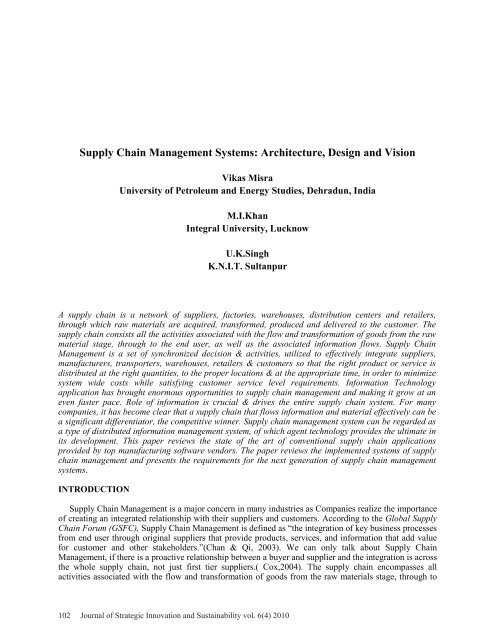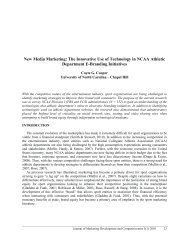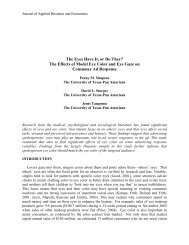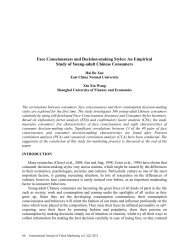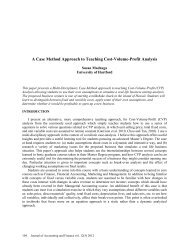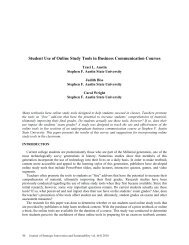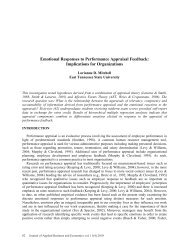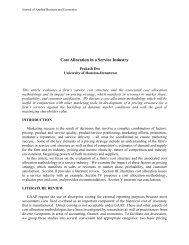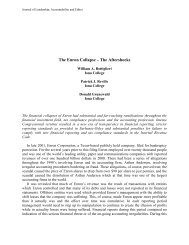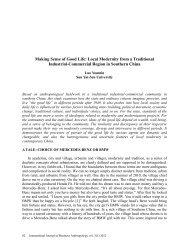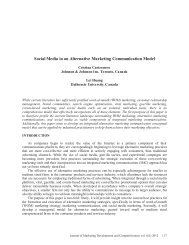Supply Chain Management Systems: Architecture, Design and Vision
Supply Chain Management Systems: Architecture, Design and Vision
Supply Chain Management Systems: Architecture, Design and Vision
Create successful ePaper yourself
Turn your PDF publications into a flip-book with our unique Google optimized e-Paper software.
<strong>Supply</strong> <strong>Chain</strong> <strong>Management</strong> <strong>Systems</strong>: <strong>Architecture</strong>, <strong>Design</strong> <strong>and</strong> <strong>Vision</strong><br />
Vikas Misra<br />
University of Petroleum <strong>and</strong> Energy Studies, Dehradun, India<br />
M.I.Khan<br />
Integral University, Lucknow<br />
U.K.Singh<br />
K.N.I.T. Sultanpur<br />
A supply chain is a network of suppliers, factories, warehouses, distribution centers <strong>and</strong> retailers,<br />
through which raw materials are acquired, transformed, produced <strong>and</strong> delivered to the customer. The<br />
supply chain consists all the activities associated with the flow <strong>and</strong> transformation of goods from the raw<br />
material stage, through to the end user, as well as the associated information flows. <strong>Supply</strong> <strong>Chain</strong><br />
<strong>Management</strong> is a set of synchronized decision & activities, utilized to effectively integrate suppliers,<br />
manufacturers, transporters, warehouses, retailers & customers so that the right product or service is<br />
distributed at the right quantities, to the proper locations & at the appropriate time, in order to minimize<br />
system wide costs while satisfying customer service level requirements. Information Technology<br />
application has brought enormous opportunities to supply chain management <strong>and</strong> making it grow at an<br />
even faster pace. Role of information is crucial & drives the entire supply chain system. For many<br />
companies, it has become clear that a supply chain that flows information <strong>and</strong> material effectively can be<br />
a significant differentiator, the competitive winner. <strong>Supply</strong> chain management system can be regarded as<br />
a type of distributed information management system, of which agent technology provides the ultimate in<br />
its development. This paper reviews the state of the art of conventional supply chain applications<br />
provided by top manufacturing software vendors. The paper reviews the implemented systems of supply<br />
chain management <strong>and</strong> presents the requirements for the next generation of supply chain management<br />
systems.<br />
INTRODUCTION<br />
<strong>Supply</strong> <strong>Chain</strong> <strong>Management</strong> is a major concern in many industries as Companies realize the importance<br />
of creating an integrated relationship with their suppliers <strong>and</strong> customers. According to the Global <strong>Supply</strong><br />
<strong>Chain</strong> Forum (GSFC), <strong>Supply</strong> <strong>Chain</strong> <strong>Management</strong> is defined as “the integration of key business processes<br />
from end user through original suppliers that provide products, services, <strong>and</strong> information that add value<br />
for customer <strong>and</strong> other stakeholders.”(Chan & Qi, 2003). We can only talk about <strong>Supply</strong> <strong>Chain</strong><br />
<strong>Management</strong>, if there is a proactive relationship between a buyer <strong>and</strong> supplier <strong>and</strong> the integration is across<br />
the whole supply chain, not just first tier suppliers.( Cox,2004). The supply chain encompasses all<br />
activities associated with the flow <strong>and</strong> transformation of goods from the raw materials stage, through to<br />
102 Journal of Strategic Innovation <strong>and</strong> Sustainability vol. 6(4) 2010
the end user, as well as the associated information flows.(Vollmann & Berry 2005) says <strong>Supply</strong> chain<br />
management (SCM) is the integration of all these activities through improved supply chain relationships,<br />
to achieve a sustainable competitive advantage [1]. For many companies, it has become clear that a<br />
supply chain that flows information <strong>and</strong> material best can be a significant differentiator, the competitive<br />
winner. The Internet is dramatically affecting the way products are bought <strong>and</strong> distributed. In Internet<br />
business, companies have to solve a major supply chain problem - how to efficiently incorporate,<br />
integrate, <strong>and</strong> utilize the rich inflows of information provided by multiple suppliers. Agents are now being<br />
regarded as an important technology to assist in helping to solve the problems of information overload<br />
<strong>and</strong> management [2]. Collaborative information agents will play a major role in the supply chain<br />
management. This paper reviews the implemented systems of SCM, <strong>and</strong> presents the requirements for<br />
next generation of SCM system. Finally, in end, multi agent system is thought as a vision of approach to<br />
next generation of SCM systems.<br />
OVER VIEW OF SUPPLY CHAIN MANAGEMENT (SCM)<br />
The pressures of the global competition <strong>and</strong> the need for the extensive inter-organizational,<br />
collaboration is forcing industries to streamline their supply chains to make them agile, flexible <strong>and</strong><br />
responsive. The old way of delivering product was to develop relatively inaccurate projections of dem<strong>and</strong>,<br />
then manufacture the product <strong>and</strong> fill up warehouses with finished goods. Aided by electronic data<br />
exchange <strong>and</strong> worldwide communications, inter-relationships among warehousing, transportation,<br />
manufacturing, procurement, <strong>and</strong> order management functions were discovered. The implemented SCM<br />
systems <strong>and</strong> techniques have substantially increased overall productivity, improved inventory <strong>and</strong><br />
shipping accuracy rates, improved inventory reduction, improved forecasting accuracy, <strong>and</strong> reduced lead<br />
time <strong>and</strong> non-value-added activities [3].<br />
Six characteristics define current supply chain management philosophy: -<br />
Shared Information<br />
Organizational Relationships<br />
Inventory <strong>Management</strong><br />
Total Pipeline Coordination<br />
Readiness to adopt Flexibility<br />
Costing Issues<br />
<strong>Supply</strong> <strong>Chain</strong> <strong>Management</strong> Applications: -<br />
SCM software applications provide real-time analytical systems that manage the flow of product <strong>and</strong><br />
information throughout the supply chain network. They are designed to enhance SCM operations -<br />
supplier sourcing, production planning, inventory planning, transportation planning, dem<strong>and</strong> planning,<br />
<strong>and</strong> so on. At present, the SCM solutions are fragmented along these functional applications into specific<br />
spaces – for example, advanced planning <strong>and</strong> scheduling for the manufacturing plant, dem<strong>and</strong> planning<br />
for the sales group, <strong>and</strong> transportation planning for the distribution center. Table 1 lists top 10<br />
manufacturing software vendors <strong>and</strong> their product suites (conducted by Plant-Wide Research Co., North<br />
Billerica, MA), where,<br />
APS: Advanced Planning <strong>and</strong> Scheduling<br />
BI: Business Intelligence<br />
CM: Component <strong>Management</strong><br />
CRM: Customer Response <strong>Management</strong><br />
EAM: Enterprise Asset <strong>Management</strong><br />
EM: Enterprise Resource Planning<br />
MES: Manufacturing Execution System<br />
PDM: Product Data <strong>Management</strong><br />
SCE: <strong>Supply</strong> <strong>Chain</strong> Execution<br />
FDM: Forecasting & Dem<strong>and</strong> <strong>Management</strong><br />
SCP: <strong>Supply</strong> <strong>Chain</strong> Planning<br />
SSC: Secure Supervisory Control<br />
T&L: Transportation & Logistics<br />
Journal of Strategic Innovation <strong>and</strong> Sustainability vol. 6(4) 2010 103
WM: Warehouse <strong>Management</strong>.<br />
The trend, however, is to consolidate these disparate functions into a comprehensive SCM suite. With<br />
the emergence of new telecommunications <strong>and</strong> information technology, new SCM systems, linking<br />
suppliers, manufacturers, distributors, retail outlets, <strong>and</strong> ultimately, customers seamlessly together,<br />
throughout the world, exchanging information almost instantly, are now being developed <strong>and</strong> studied.<br />
TABLE 1<br />
TOP 10 MANUFACTURING SOFTWARE VENDORS AND THEIR APPLICATIONS<br />
Company Software Categories Product Suite<br />
SAP America<br />
(www.sap.com)<br />
APS, CRM, E-Business, ERP, PDM,<br />
PDM, CM, Groupware, SCP<br />
SAP R/3<br />
Oracle Corp.<br />
(www.oracle.com)<br />
APS, CRM, E-Business, ERP, FDM,<br />
PDM, SCP<br />
Oracle Applications<br />
J.D. Edwards<br />
(www.JDEdwards.com)<br />
APS, CRM, E-Business, ERP, FDM,<br />
SCP, WM, Groupware,<br />
OneWorld, ActivEra,<br />
Genesis, World<strong>Vision</strong>,<br />
Baan Company, The APS, CRM, ERP, PDM, CM, Baan ERP<br />
(www.ban.com) Groupware, SCP<br />
JBA International<br />
(www.jbaworld.com)<br />
ERP, WM System 21<br />
I2 Technologies APS, E-Business, FDM RHYTHM, Optiflex,<br />
(www.i2.com)<br />
Think Dem<strong>and</strong><br />
InterBiz <strong>Supply</strong> <strong>Chain</strong> Group<br />
(www.cai.com)<br />
APS, BI, E-Business, ERP, FDM, InterBiz Solutions<br />
DM, CM, Groupware, SCE, SCP,<br />
Foxboro Co., The MES, SSL I/A Series Intelligent<br />
(www.foxboro.com)<br />
Automation<br />
Peoplesoft, Inc<br />
(www.peoplesoft.com)<br />
APS,BI,CRM,E-Business, ERP, CM,<br />
SCP<br />
Peoplesoft Solutions<br />
Manugistics<br />
(www.manugistics.com)<br />
E-Business, SCP<br />
Manugistics6<br />
Enterprise Resource Planning (ERP) Vs. <strong>Supply</strong> <strong>Chain</strong> <strong>Management</strong> (SCM)<br />
ERP is a strategic tool, which helps the company to gain competitive edge by integrating all business<br />
processes <strong>and</strong> optimizing the resources available. It equips the enterprise with the necessary capabilities<br />
to integrate <strong>and</strong> synchronize the isolated functions into streamlined business processes. ERP is being<br />
implemented in almost all types of organizations irrespective of its mode <strong>and</strong> spread of operation.<br />
However, ERP is sometimes confused with SCM [4].<br />
(1) An enterprise system (such as ERP) is a system for a single company, attempting to integrate most of<br />
the business activities within that company. But a supply chain almost always spans across multiple<br />
companies, <strong>and</strong> involves only a relatively few people <strong>and</strong> resources within each company. One enterprise<br />
may be involved in many supply chains, for different product lines or<br />
Different markets for the same product line.<br />
(2) The most distinguishing characteristic of ERP systems is their comprehensiveness. Some ERP<br />
systems broadly cover sales <strong>and</strong> distribution, business planning, production planning, shop floor control,<br />
<strong>and</strong> logistics. On the surface, this would seem to cover anything that SCM claims to provide. However,<br />
effective SCM enables to make informed decisions along the entire supply chain. <strong>Supply</strong> chain should be<br />
planned <strong>and</strong> optimized as a continuous <strong>and</strong> seamless activity that integrates all planning functions across<br />
the supply chain. It goes beyond traditional planning solutions by simultaneously considering dem<strong>and</strong>,<br />
capacity <strong>and</strong> material constraints.<br />
(3) Real-time information throughout the entire supply chain is needed to make correct decisions, <strong>and</strong><br />
SCM products are designed to gather that real-time information. Traditional ERPsystems generally do not<br />
gather real-time information from everywhere in the supply chain - on the contrary, they often contain<br />
static, dated information only related to subsections of the supply chain. Getting answers from an<br />
104 Journal of Strategic Innovation <strong>and</strong> Sustainability vol. 6(4) 2010
overloaded ERP systems may take hours, whereas getting them from a separate, memory resident, always<br />
running SCM system may take minutes or seconds.<br />
NEXT GENERATION OF SUPPLY CHAIN MANAGEMENT<br />
Today, virtually all industries <strong>and</strong> most companies are facing a more dynamic environment - that is,<br />
greater uncertainty of dem<strong>and</strong>, shorter product life cycles, greater dem<strong>and</strong> for mass customization, more<br />
significant seasonality, higher competitive intensity, fewer warehouses, more third-party service, new<br />
cost/service balance, globalization, channel integration, <strong>and</strong> so on. However, almost all existing supply<br />
chain systems are featured in one or more of the following demerits: product availability focus; reactive<br />
rather than proactive; long lead times; uncertainty throughout; lack of flexibility in systems; performance<br />
measured functionally; poorly defined management process; no real partnerships; product price lead<br />
relationship; paper, phone, fax based relationship; performance measures insufficient. In order to<br />
overcome all of these shortcomings, next generation of supply chain management systems are required to<br />
meet the needs.<br />
Requirements for Next Generation of SCM<br />
The next generation of SCM should possess the following set of characteristics: integrated, customercentric,<br />
distributed; having interoperability, scalability; with open <strong>and</strong> flexible infrastructure;<br />
autonomous, capable of self-organization <strong>and</strong> reconfiguration, coordination <strong>and</strong> negotiation; with<br />
optimization <strong>and</strong> learning mechanism so evolve in <strong>and</strong> adapt to the dynamic marketplaces; synchronized<br />
<strong>and</strong> agile (to h<strong>and</strong>le rapid change); involving production planning <strong>and</strong> scheduling; capable of making<br />
forecasts accurately; both active <strong>and</strong> proactive; compatible with globalized manufacturing; seamlessly<br />
Integratable with E-commerce <strong>and</strong> M-commerce; <strong>and</strong> proper performance-measurements. These<br />
characteristics are interrelated.<br />
Integration: The keyword that appears throughout the whole new generation of supply chain is<br />
integration, because it spells the difference between the old view of logistics as the discrete functions of<br />
transportation <strong>and</strong> distribution, <strong>and</strong> the new vision of SCM that links all the players <strong>and</strong> activities<br />
involved in converting raw materials into products <strong>and</strong> delivering those products to consumers at the right<br />
time <strong>and</strong> at the right place in the most efficient manner. Business success will be increasingly dependent<br />
on functional integration.<br />
Integrate with E-Commerce <strong>and</strong> M-Commerce: While e-commerce offers some exciting opportunities to<br />
improve SCM effectiveness by lowering costs <strong>and</strong> increasing the speed of order-to-delivery, it is by no<br />
means the first stop on the path to having highly competitive e-supply chain capabilities. E-commerce is<br />
digitally connecting the entire world into one big network of supply chains. E-commerce already has, <strong>and</strong><br />
will continue, to fundamentally change business to- business [B2B], business-to-consumer [B2C], <strong>and</strong><br />
business-to-employee [B2E] supply chain models. Mutually, E-commerce requires intelligent supply<br />
chains that provide instant access to the right data anywhere. With the new development of mobile<br />
communication <strong>and</strong> wireless technology, it will usher in the next wave of electronic commerce - the socalled<br />
m-commerce. It allows users to access systems whenever they want without physically being<br />
connected to the network.<br />
Engage in collaborative supply chain planning, scheduling <strong>and</strong> optimization: SCP enables companies<br />
to intelligently manage the activities of the supply chain. Collaborative SCP involves improving the<br />
coordination <strong>and</strong> information sharing for all activities, from supplier's supplier to customer's customer. In<br />
addition to coordinating activities across the entire product life cycle, SCP involves a comprehensive<br />
solution including changes made in alliance strategy, business process, performance measures <strong>and</strong><br />
technology. The appeal of APS solutions to manufacturers is obvious: companies can optimize their<br />
supply chains to reduce costs, improve product margins, lower inventories, <strong>and</strong> increase manufacturing<br />
throughput. Exploiting Internet for collaborative SCP provides a critical link for sharing information,<br />
planning & scheduling supply chain activities.<br />
Integration of performance measurement: The performance of a supply chain activity should be<br />
measured globally. The most notable measures for customer service include short order lead times <strong>and</strong> instock<br />
availability. Such measures also may include order <strong>and</strong> invoice accuracy, access to information on<br />
order status, ability to respond to customer inquiries, <strong>and</strong> so on.<br />
Journal of Strategic Innovation <strong>and</strong> Sustainability vol. 6(4) 2010 105
Customer-centric service: Providing online commitments for orders <strong>and</strong> schedules is key to enhancing<br />
customer service <strong>and</strong> gaining a competitive advantage. Many companies envision this capability as part of<br />
the SCM strategy. Also, dynamic webpage creation capability is needed to a customer-centric system.<br />
The next evolutionary stage of SCM solves customer problems by. [5]<br />
Gathering & analyzing knowledge & personalized data about customers, their problems, <strong>and</strong> their<br />
unmet needs.<br />
Identifying partners to perform the functions needed in the dem<strong>and</strong> chain.<br />
Moving the functions that need to be done to the channel member that can perform them most<br />
effectively <strong>and</strong> efficiently.<br />
Sharing with the other chain members’ knowledge about consumers <strong>and</strong> customers, available<br />
<br />
technology, <strong>and</strong> logistics challenges <strong>and</strong> opportunities.<br />
Developing products, services <strong>and</strong> executing the best logistics, transportation, <strong>and</strong> distribution<br />
methods to deliver products <strong>and</strong> services to consumers in the desired format.<br />
Globalization: SCM is being viewed as a global strategic issue that recognizes the significant cost <strong>and</strong><br />
service improvements to be gained by viewing the supply chain as a whole encompassing everything<br />
from initial supplier to final customer fulfillment. <strong>Supply</strong> chain globalization is the process of corporate<br />
structuring that focuses all supply chain applications on a single, worldwide market, creating growth <strong>and</strong><br />
profit opportunities through synergies <strong>and</strong> efficiencies in engineering, sales, purchasing, production <strong>and</strong><br />
distribution. Globalized supply chain supports multilingual translations.<br />
Synchronization: Next generation of supply chain suites will synchronize supplier planning, production<br />
planning, logistics planning, <strong>and</strong> dem<strong>and</strong> planning. These solutions will provide a comprehensive view of<br />
all supply chain activities <strong>and</strong> enable upper management to make more informed tradeoff decisions.<br />
<strong>Supply</strong> chain synchronization is the secret to improving customer service without increasing inventory<br />
investment. A capable supply chain matches the rate of supply with the rate of dem<strong>and</strong> at each node. It<br />
synchronizes the product mix that is in production with the product mix that customers order.<br />
Agility: SCM systems must be able to process transactions rapidly <strong>and</strong> accurately. In today‘s business<br />
environment it is important that a business be agile as well as efficient. Organizations must focus on<br />
moving information <strong>and</strong> products quickly through the entire supply chain, distribution, assembly<br />
manufacture <strong>and</strong> supply.<br />
Inter-enterprise collaboration: Collaboration entails sharing once-distinct proprietary business processes.<br />
To illustrate, a manufacturer <strong>and</strong> retailer may collaborate to determine the best forecast for each product<br />
category. Or a supplier <strong>and</strong> manufacturer may collaborate to create a new product. In fact, SCM rests<br />
upon the concept of trading partners <strong>and</strong> extended partners collaborating for competitive advantage.<br />
Capture <strong>and</strong> Manage dem<strong>and</strong>: Next generation SCM solutions are designed to enable dem<strong>and</strong> capture<br />
for intra- <strong>and</strong> inter-enterprise constituents through a distributed architecture with web browser access. In<br />
this scenario, the dem<strong>and</strong> planner is designed as an integral part of a single data model solution that<br />
provides tight integration between dem<strong>and</strong> & supply planning. Once dem<strong>and</strong> has been captured in the<br />
system, the dem<strong>and</strong> planner can aggregate & match dem<strong>and</strong> against supply constraints to determine the<br />
appropriate commitment for a customer’s forecast.<br />
Webification: Web-enabled technologies that speed the flow of information <strong>and</strong> decision-making across<br />
the supply chain offer significant competitive advantage. Internet technology can deliver what the<br />
customer wants - timeliness, accuracy <strong>and</strong> low cost. Customers previously had to call a customer service<br />
representative, while now orders can be taken <strong>and</strong> tracked online, <strong>and</strong> a customer’s credit status can be<br />
verified online. This provides a tighter integration between consumers <strong>and</strong> producers. In B2B<br />
marketplace, companies are beginning to shift SCM functions themselves to the web.<br />
Coordination: In order to operate efficiently, supply chain applications must work in a tightly<br />
coordinated manner. However, the dynamics of the enterprise <strong>and</strong> of the world market make this difficult.<br />
In many cases, unpredictable events can not be dealt with locally, i.e. within the scope of a single supply<br />
chain “agent”, requiring several agents to coordinate in order to revise plans, schedules or decisions.<br />
Learning: <strong>Supply</strong> chain is a complex system - large, open, dynamic, <strong>and</strong> unpredictable. For such system<br />
it is extremely difficult <strong>and</strong> sometimes even impossible to correctly & completely specify these systems a<br />
priori, that is, at the time of their design <strong>and</strong> priori to their use. Next generation of SCM would deal with<br />
the usage of machine learning concepts to treat supply chain activities. It must have the capability to learn<br />
106 Journal of Strategic Innovation <strong>and</strong> Sustainability vol. 6(4) 2010
to change, be able to adapt to new ways of doing business as a flexible information system, & have the<br />
vision to recognize the need for & the direction of change.<br />
Distributed Information <strong>Management</strong> System (DIMS)<br />
Next generation of SCM system is a type of DIMS. In I.T. era, the more information that becomes<br />
available electronically gives people potentially greater diversity <strong>and</strong> choice, but means that more time<br />
will be expended in sorting the relevant information from the irrelevant. The large number of<br />
applications, communication protocols <strong>and</strong> data formats result in a heterogeneous network information<br />
system, <strong>and</strong> the dynamic nature of information repositories causes the inconsistent <strong>and</strong> incomplete<br />
information distribution on Internet. The aim of DIMS is to develop <strong>and</strong> provide methods for managing<br />
change <strong>and</strong> evolution, not just discovering or retrieving, in a large, distributed networked environment.<br />
Multi agent systems are the best way to characterize or design distributed information management<br />
systems. Multi agent environments provide an infrastructure specifying communication <strong>and</strong> interaction<br />
protocols. They are typically open <strong>and</strong> have no centralized designer. They contain agents that are<br />
autonomous & distributed, & may be self-interested or cooperative.<br />
AGENT-BASED SCM: THE VISION<br />
An agent is a computer system that is situated in some environment, <strong>and</strong> that is capable of autonomous<br />
action in this environment in order to meet its design objectives [7]. A generic agent has a set of goals (or<br />
intentions), certain capabilities to perform actions, <strong>and</strong> some knowledge (or beliefs) about its<br />
environment. To achieve its goals, an agent needs to reason about its environment (as well as behaviors of<br />
other agents), to generate plans <strong>and</strong> to execute these plans. Intelligent agents - regarded as software<br />
entities that exhibit autonomy <strong>and</strong> environmental awareness enabling their interaction with the<br />
environment (e.g. with other agents) to achieve internal goals - have become very popular in the past<br />
decade. Agents are needed to coordinate - either through cooperation, competition, or a combination of<br />
both. These agent “societies” are called multi agent systems (MAS). Multi agent systems may be regarded<br />
as a group of agents, interacting with one another to collectively achieve their goals. By drawing on other<br />
agents’ knowledge <strong>and</strong> capabilities, agents can overcome their inherent bounds of intelligence. Many<br />
real-world systems are naturally distributed by spatial, functional, or temporal differences, therefore,<br />
MAS can easily fit into such distributed environments. There are a wide range of application domains that<br />
are making use of agent-based systems: enterprise applications; B2B applications; process control;<br />
personal agents; information management tasks (searching for information, information filtering,<br />
information monitoring, data source mediation, interface agents/personal assistants); nomadic computing<br />
applications [8].<br />
Agents can help transform closed trading partner networks into open markets <strong>and</strong> extend such<br />
applications as production, distribution, <strong>and</strong> inventory management functions across entire supply chains<br />
spanning diverse organizations.<br />
CONCLUSIONS<br />
The review of commercial SCM applications has presented the state of the art in the field of SCM.<br />
Some requirements have been proposed for next generation of SCM systems. Agent-based SCM systems<br />
provide a single solution for managing the next generation of SCM in a multi-plant, inter-enterprise<br />
environment. Future efforts seem to be focused only on the Multi agent-based approaches to integrated<br />
<strong>and</strong> globalized SCM. All achievements in agent-based SCM systems implementation can be extended to<br />
develop other distributed information management systems.<br />
REFERENCES<br />
Hanfield R. B.,Nichols E. L. (1999), Introduction to <strong>Supply</strong> <strong>Chain</strong> <strong>Management</strong>, Prentice Hall Press, 143-<br />
156.<br />
Maes P.,(1997) Humanizing Global Computer, IEEE Internet Computing, vol.1(4),10-19.<br />
Journal of Strategic Innovation <strong>and</strong> Sustainability vol. 6(4) 2010 107
Anderson D. L. <strong>and</strong> Lee H., (1999)“Synchronized <strong>Supply</strong> <strong>Chain</strong>s: The New Frontier”, White Paper,<br />
Achieving <strong>Supply</strong> <strong>Chain</strong> Excellence through Technology, 34-39.<br />
Kumar. K <strong>and</strong> Hillegersberg J. V.,(2000) “ERP Experiences <strong>and</strong> Evolution”, Communications of the<br />
ACM, vol. 43, no 4, pp. 22-26.<br />
Sheth J,Sisodia R,Sharma A.,(2000) “The Antecedents <strong>and</strong> Consequences of Customer-Centric<br />
Marketing”, Journal of Academy of Market Science, vol. 28, no 1,55-66.<br />
Moakley,(2006) “Third Generation E-Business & the <strong>Supply</strong> Lattice”, White Paper, Intel Corporation,<br />
25-36.<br />
Wooldridge M. & Jennings N. R.,(2005) ‘‘Intelligent Agents: Theory <strong>and</strong> Practice”, The Knowledge<br />
Engineering Review, vol. 10, no 2, pp. 115-152.<br />
Jennings N.R., <strong>and</strong> Wooldridge M.,(2003) “Applications of Intelligent Agents”, in Agent Technology:<br />
Foundations, Applications, <strong>and</strong> Markets pp. 3-28,2003.<br />
108 Journal of Strategic Innovation <strong>and</strong> Sustainability vol. 6(4) 2010


